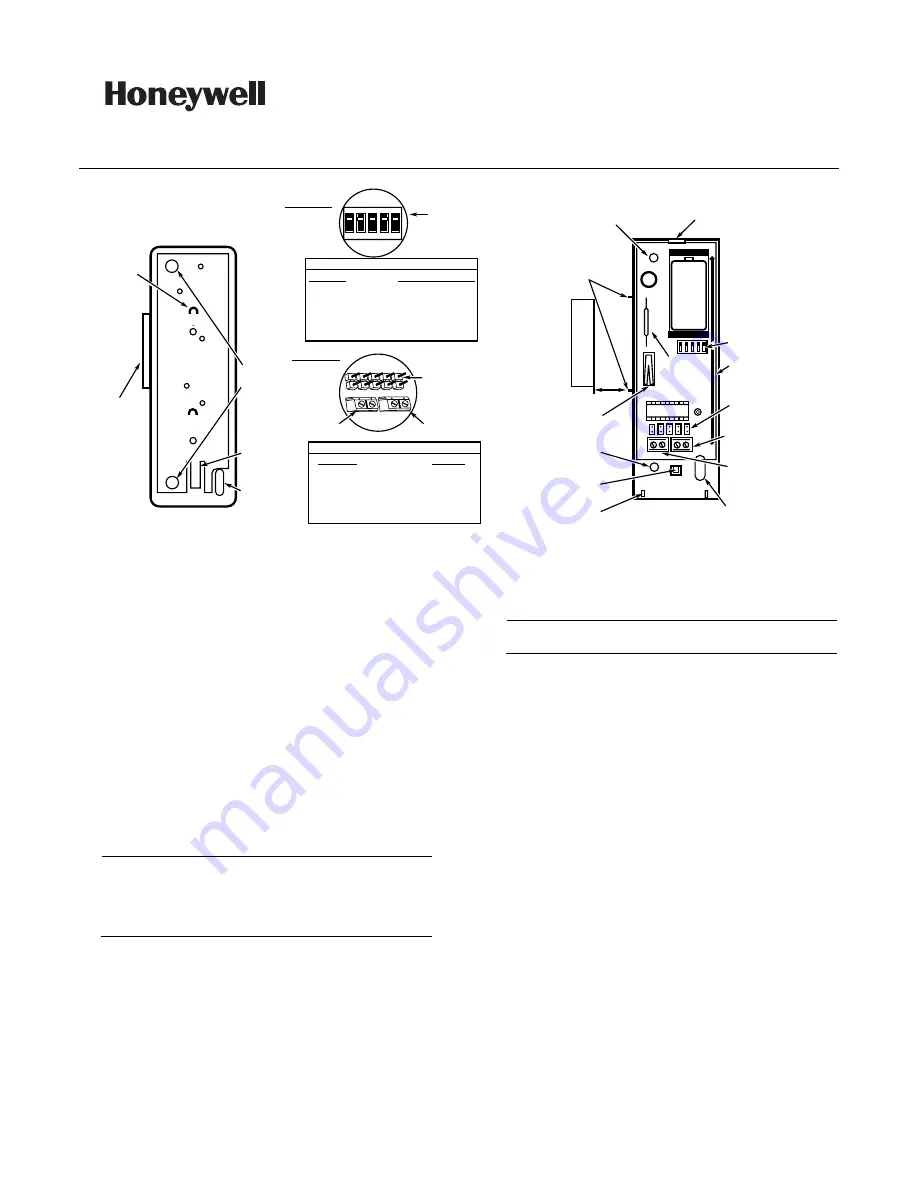
ADEMCO 5819
SHOCK PROCESSOR TRANSMITTER
INSTALLATION AND SETUP GUIDE
+
–
B
A
TTER
Y
REED
SWITCH
(LOOP 2)
COVER PRY-0FF POINT
ALIGN MAGNET
WITH MARKS ON
CASE AND GUIDE
ON MTG. PLATE
MAGNET
(OBTAIN
SEPARATELY)
LOOP 1 TERMINALS
(See Detail “B”)
LOCKING TAB
RELEASE WINDOW
COVER HOLDING
HOOKS (2)
COVER
TAMPER
SWITCH
MOUNTING
HOLE
ANTENNA
DIP SWITCHES
See Detail “A”
DIP
SWITCHES
JUMPER PINS
See Detail “B”
SLOT FOR
CONCEALED
WIRING ACCESS
MA
GNET
Diagram 2: 5819 (SHOWN WITH COVER REMOVED)
1/2"
MAX
1
2
3
4
5
ON
TB2
TB1
MAGNETIC
ALIGNMENT
GUIDE
STRIP
RELEASE
FOR
BRACKET
CASE
HOLDING
POSTS
(2)
SLOT
FOR
WIRE
SCREW
HOLES
Diagram 1: MOUNTING PLATE
TABLE 1
SWITCH
RESPONSE TIME
SW1 (Most Sensitive)
1ms
SW2
2ms
SW3
5ms
SW4
10ms
SW5 (Least Sensitive)
20ms
JUMPER
PINS
SHOCK SENSOR
TERMINALS
(INPUT LOOP 1)
TABLE 2
JUMPER
COUNT
J1
(Most Sensitive)
1
J2
2
J3
4
J4
6
J5
(Least Sensitive)
8
J5 J4 J3 J2 J1
DETAIL B
DETAIL A
CONTACT
TERMINALS
(INPUT LOOP 3)
LOOP 3 TERMINALS
(See Detail “B”)
5819 -001-V1
MOUNTING HOLE
GENERAL INFORMATION
The ADEMCO 5819 Shock Processor Transmitter connects to
inertia type shock detectors that are mounted externally to the
transmitter case (detector not supplied), and is intended for use
only with a wireless alarm system that supports 5800 Series
wireless receivers.
The 5819 has three unique zones. The first is for a wired,
normally closed shock sensor loop (TB1), the second is for a
closed contact loop using the unit's built-in magnetic reed switch
in conjunction with a magnet, and the third is for a wired closed
circuit contact loop (TB2).
The 5819 has a built-in cover tamper switch that activates when
the cover is removed.
INSTALLATION
Mounting
For proper orientation of the unit in relation to the mounting plate,
loop wiring, DIP switch adjustment, jumper positions, and/or
magnet, read all of this section before installing the unit.
!
Do not mount the transmitter on or near metal
objects, as this may affect transmission range. It is
also good practice to avoid locating the transmitter
near wiring such as AC, telephone, HVAC,
computer data cables, etc.
The description that follows assumes that the unit will be
mounted as shown in the diagrams, with the magnet (if used)
located to the left of the unit. The unit can be installed in any
direction, as long as the relationship of the unit to its mounting
plate and (if used) magnet is maintained.
Although two mounting holes are provided in the unit that would
permit mounting directly to a surface, it is recommended that the
mounting plate be used as described in this document, for ease
in removing the unit for servicing should it become necessary.
Before mounting the transmitter permanently, conduct Go/No Go
tests (see control's instructions) to verify adequate signal strength
and reorient or relocate the transmitter if necessary.
1.
Remove transmitter's cover by inserting the flat blade of a
small screwdriver into the pry-off slot nearest to the cover's
decorative ribs, and twisting the blade.
!
Do not remove the printed circuit board from its
plastic case!
2. Disengage the supplied mounting plate from the unit by
inserting the blade of a small screwdriver into the locking tab
release window (see Diagram 2) and pressing it against the
locking tab (see Diagram 1) while sliding the plate
downward along the case back.
3.
If a shock processor or wired contact loop is to be used with
concealed wiring, feed the wires through the concealed
wiring entry hole at one corner of the plate. For surface
wiring entry, a thin "breakout" area is provided in the case
wall.
4. Install the mounting plate, with its case-holding posts
pointing up (in this example), in the location selected.
5.
Attach the case back to the mounting plate by sliding the
keyhole slots in the case back down onto the mounting
plate's case-holding posts. The locking tab will click as the
case back locks in place.
6.
If the unit's REED SWITCH is to be used, mount a 5799
Magnet (obtained separately) adjacent to the alignment
marks on the case and the mounting plate's alignment strip
(see Diagram 2).
7.
Set response time (from Table 1) using the DIP switches.
SW1 sets a response time of 1mS. SW5 sets a response
time of 20mS. For a response time of 0.5mS, set all DIP
switches to OFF (as shown in DETAIL A in Diagram 1
above).
8.
Set the pulse count jumper (see Table 2). The pulse count
is reset 3-seconds after the first pulse is detected. There is
an LED on the PCB that flashes rapidly on transmission.
Note: Make the device highly sensitive for the purpose
of enrolling the shock sensor loop (TB1) into the system
(turn SW1 on and put jumper on J1). After the device
has been enrolled, adjust settings as described in steps
7 and 8 (above).




















